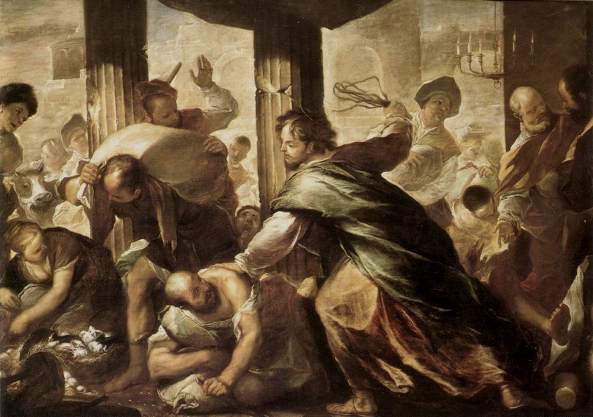
Giotto – "Explusion of the Moneychangers from the Temple" (1304-1306)

El Greco– "Purification of the Temple" (1570’s)

Valentine de Boulogne – "Expulsion of the Moneychangers from the Temple " (1620-1625)

Rembrandt- "Christ Driving the Moneychangers from the Temple " (1626)

Jordeans – "Christ Driving the Merchants from the Temple " (1650)

Giordano – "Jesus Cleansing the Temple" (1670’s)

"The Explusion from the Temple" (18th century)

Bloch – "Christ Cleansing the Temple" (1875)

Tissot – "The Merchants Chased from the Temple" (1886-1894)

William Roberts– "Christ Driving the Moneychangers from the Temple" (1922-1925)
At the time of the Reformation, this story symbolized Luther’s condemnation of the sale of papal indulgences. For this reason it was popular with painters from Protestant countries. Christ’s outburst was not typical of him – perhaps this is why it caught people’s imagination.
In ancient times the whip was applied to criminals and animals: the sentence ‘and Jesus made a whip of cords and drove them out of the Temple’ therefore had particular significance for people at that time.
The beasts were sold as sacrificial animals, the sheep and oxen for the rich, the pigeons for the poor. Paintings of another incident in the life of Jesus, the Presentation in the Temple, often show Joseph offering pigeons, because his family was poor.
Doves and pigeons were symbols of innocence and peace.
The scene, of Jesus driving animals before him and overturning tables and benches, is one of general confusion. It implied the supplanting of ancient Judaism by Christianity. The merchants are fending off the blows, making for the doors.
The money-changers scramble to collect their money before it is scattered, or clutch their purses. All the traders looked shocked at this surprise attack.
According to Matthew the episode took place in the Temple courtyard, but the scene is often shown inside a building. Only the gospel writer John mentions the whip.
